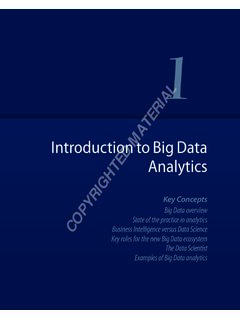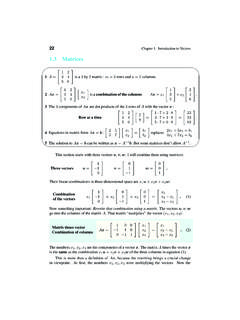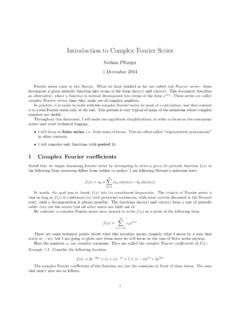Transcription of Integers and Introduction to Integers
1 Copyright 2011 Pearson Education, Inc. Publishing as Prentice Hall. Chapter 2 Integers and Introduction to Integers Copyright 2011 Pearson Education, Inc. Publishing as Prentice Hall. Introduction to Integers Martin-Gay, Prealgebra, 6ed 3 3 Copyright 2011 Pearson Education, Inc. Publishing as Prentice Hall. Numbers greater than 0 are called positive numbers. Numbers less than 0 are called negative numbers. negative numbers zero positive numbers 6 5 4 3 2 1 0 -1 -2 -3 -4 -5 -6 Positive and Negative Numbers Martin-Gay, Prealgebra, 6ed 4 4 Copyright 2011 Pearson Education, Inc. Publishing as Prentice Hall. Some signed numbers are Integers . negative numbers zero positive numbers 6 5 4 3 2 1 0 1 2 3 4 5 6 The Integers are { .., 6, 5, 4, 3, 2, 1, 0, 1, 2, 3, 4, 5, 6.}
2 } Integers Martin-Gay, Prealgebra, 6ed 5 5 Copyright 2011 Pearson Education, Inc. Publishing as Prentice Hall. 3 indicates negative three. 3 and + 3 both indicate positive three. The number 0 is neither positive nor negative. negative numbers zero positive numbers 6 5 4 3 2 1 0 1 2 3 4 5 6 Negative and Positive Numbers Martin-Gay, Prealgebra, 6ed 6 6 Copyright 2011 Pearson Education, Inc. Publishing as Prentice Hall. We compare Integers just as we compare whole numbers. For any two numbers graphed on a number line, the number to the right is the greater number and the number to the left is the smaller number. < means is less than > means is greater than Comparing Integers Martin-Gay, Prealgebra, 6ed 7 7 Copyright 2011 Pearson Education, Inc. Publishing as Prentice Hall.
3 The graph of 5 is to the left of 3, so 5 is less than 3, written as 5 < 3 . We can also write 3 > 5. Since 3 is to the right of 5, 3 is greater than 5. 6 5 4 3 2 1 0 -1 -2 -3 -4 -5 -6 6 5 4 3 2 1 0 1 2 3 4 5 6 Graphs of Integers Martin-Gay, Prealgebra, 6ed 8 8 Copyright 2011 Pearson Education, Inc. Publishing as Prentice Hall. The absolute value of a number is the number s distance from 0 on the number line. The symbol for absolute value is | |. 2is 2 because 2 is 2 units from 0. 6 5 4 3 2 1 0 1 2 3 4 5 6 is 2 because 2 is 2 units from 0. 2 6 5 4 3 2 1 0 1 2 3 4 5 6 Absolute Value Martin-Gay, Prealgebra, 6ed 9 9 Copyright 2011 Pearson Education, Inc. Publishing as Prentice Hall. Since the absolute value of a number is that number s distance from 0, the absolute value of a number is always 0 or positive.
4 It is never negative. 0 = 06 = 6 zero a positive number Helpful Hint Martin-Gay, Prealgebra, 6ed 10 10 Copyright 2011 Pearson Education, Inc. Publishing as Prentice Hall. Two numbers that are the same distance from 0 on the number line but are on the opposite sides of 0 are called opposites. 5 units 5 units 5 and 5 are opposites. 6 5 4 3 2 1 0 1 2 3 4 5 6 Opposite Numbers Martin-Gay, Prealgebra, 6ed 11 11 Copyright 2011 Pearson Education, Inc. Publishing as Prentice Hall. 5 is the opposite of 5 and 5 is the opposite of 5. The opposite of 4 is 4 is written as (4) = 4 The opposite of 4 is 4 is written as ( 4) = 4 ( 4) = 4 If a is a number, then ( a) = a. Opposite Numbers Martin-Gay, Prealgebra, 6ed 12 12 Copyright 2011 Pearson Education, Inc.
5 Publishing as Prentice Hall. Remember that 0 is neither positive nor negative. Therefore, the opposite of 0 is 0. Helpful Hint Copyright 2011 Pearson Education, Inc. Publishing as Prentice Hall. Adding Integers Martin-Gay, Prealgebra, 6ed 14 14 Copyright 2011 Pearson Education, Inc. Publishing as Prentice Hall. 6 5 4 3 2 1 0 -1 -2 -3 -4 -5 -6 Adding Two Numbers with the Same Sign 2 + 3 = 2 Start End 2 + ( 3) = 2 3 Start End 3 6 5 4 3 2 1 0 1 2 3 4 5 6 6 5 4 3 2 1 0 1 2 3 4 5 6 5 5 Martin-Gay, Prealgebra, 6ed 15 15 Copyright 2011 Pearson Education, Inc. Publishing as Prentice Hall. Adding Two Numbers with the Same Sign Step 1: Add their absolute values. Step 2: Use their common sign as the sign of the sum. Examples: 3 + ( 5) = 8 5 + 2 = 7 Martin-Gay, Prealgebra, 6ed 16 16 Copyright 2011 Pearson Education, Inc.
6 Publishing as Prentice Hall. Adding Two Numbers with Different Signs 2 + ( 3) = 2 3 2 + 3 = 2 3 Start End Start End 6 5 4 3 2 1 0 1 2 3 4 5 6 6 5 4 3 2 1 0 1 2 3 4 5 6 1 1 Martin-Gay, Prealgebra, 6ed 17 17 Copyright 2011 Pearson Education, Inc. Publishing as Prentice Hall. Step 1: Find the larger absolute value minus the smaller absolute value. Step 2: Use the sign of the number with the larger absolute value as the sign of the sum. Examples: 4 + 5 = 1 6 + ( 8) = 2 Adding Two Numbers with Different Signs Martin-Gay, Prealgebra, 6ed 18 18 Copyright 2011 Pearson Education, Inc. Publishing as Prentice Hall. If a is a number, then a is its opposite. a + ( a) = 0 a + a = 0 The sum of a number and its opposite is 0. Helpful Hint Martin-Gay, Prealgebra, 6ed 19 19 Copyright 2011 Pearson Education, Inc.
7 Publishing as Prentice Hall. Don t forget that addition is commutative and associative. In other words, numbers may be added in any order. Helpful Hint Martin-Gay, Prealgebra, 6ed 20 20 Copyright 2011 Pearson Education, Inc. Publishing as Prentice Hall. Evaluate x + y for x = 5 and y = 9. x + y = ( ) + ( ) Replace x with 5 and y with 9 in x + y. 5 9 = 4 Evaluating Algebraic Expressions Copyright 2011 Pearson Education, Inc. Publishing as Prentice Hall. Subtracting Integers Martin-Gay, Prealgebra, 6ed 22 22 Copyright 2011 Pearson Education, Inc. Publishing as Prentice Hall. To subtract Integers , rewrite the subtraction problem as an addition problem. Study the examples below. 9 5 = 4 9 + ( 5) = 4 equal 4, we can say 9 5 = 9 + ( 5) = 4 Since both expressions Subtracting Integers Martin-Gay, Prealgebra, 6ed 23 23 Copyright 2011 Pearson Education, Inc.
8 Publishing as Prentice Hall. Subtracting Two Numbers If a and b are numbers, then a b = a + ( b). To subtract two numbers, add the first number to the opposite (called additive inverse) of the second number. Martin-Gay, Prealgebra, 6ed 24 24 Copyright 2011 Pearson Education, Inc. Publishing as Prentice Hall. subtraction = first number + opposite of second number 7 4 = 7 + ( 4) = 3 5 3 = 5 + ( 3) = 8 3 ( 6) = 3 + 6 = 9 8 ( 2) = 8 + 2 = 6 Subtracting Two Numbers Martin-Gay, Prealgebra, 6ed 25 25 Copyright 2011 Pearson Education, Inc. Publishing as Prentice Hall. If a problem involves adding or subtracting more than two Integers , rewrite differences as sums and add. By applying the associative and commutative properties, add the numbers in any order.
9 9 3 + ( 5) ( 7) = 9 + ( 3) + ( 5) + 7 6 + ( 5) + 7 1 + 7 8 Adding and Subtracting Integers Martin-Gay, Prealgebra, 6ed 26 26 Copyright 2011 Pearson Education, Inc. Publishing as Prentice Hall. Evaluate x y for x = 6 and y = 8. x y Replace x with 6 and y with 8 in x y. = ( ) ( ) 6 8 = 14 = ( ) + ( ) 6 8 Evaluating Algebraic Expressions Copyright 2011 Pearson Education, Inc. Publishing as Prentice Hall. Multiplying and Dividing Integers Martin-Gay, Prealgebra, 6ed 28 28 Copyright 2011 Pearson Education, Inc. Publishing as Prentice Hall. Consider the following pattern of products. 3 5 = 15 2 5 = 10 1 5 = 5 0 5 = 0 This pattern continues as follows. 1 5 = - 5 2 5 = - 10 3 5 = - 15 This suggests that the product of a negative number and a positive number is a negative number.
10 First factor decreases by 1 each time. Product decreases by 5 each time. Multiplying Integers Martin-Gay, Prealgebra, 6ed 29 29 Copyright 2011 Pearson Education, Inc. Publishing as Prentice Hall. 2 ( 5) = 10 0 ( 5) = 0 This pattern continues as follows. 1 ( 5) = 5 2 ( 5) = 10 3 ( 5) = 15 This suggests that the product of two negative numbers is a positive number. Product increases by 5 each time. 1 ( 5) = 5 Observe the following pattern. Multiplying Integers Martin-Gay, Prealgebra, 6ed 30 30 Copyright 2011 Pearson Education, Inc. Publishing as Prentice Hall. Multiplying Integers The product of two numbers having the same sign is a positive number. 2 ( 4) = 8 2 4 = 8 2 ( 4) = 8 2 4 = 8 The product of two numbers having different signs is a negative number.
















